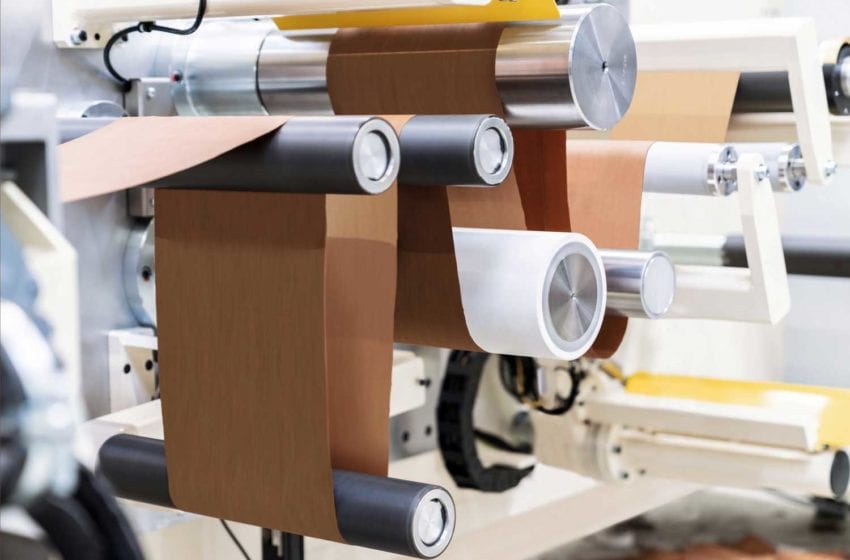Recon Reconsidered
- Also in TR Print Edition Technology
- February 1, 2021
- 0
- 10 minutes read


Garbuio has developed a new process for making reconstituted leaf tobacco.
By Stefanie Rossel
With the advent of heated-tobacco products (HTPs), reconstituted tobacco leaf (RTL) experienced a renaissance. The consumables of HTPs require a dedicated form of recon, custom-made from carefully blended tobacco leaves. Invented in the 1950s to save the valuable raw material by combining remnants of virgin tobacco during production, recon is today used in the tobacco blend to reduce the filling cost for cigarettes, cigars or of pipe and smoking tobacco blends. It also plays an essential role in cigarette blend design. Enriched with cloves for kretek cigarettes or containing hemp components, RTL even allows for the creation of completely new products.
There are several methods to produce reconstituted tobacco. Next to the paper-making technique, there is the nano fiber technology and a process called band cast, which is also known as slurry-type recon. All recon types can be used in HTP consumables. Paper recon and slurry recon are currently the most widely used forms but require much space and energy to produce, while taste, drying and tensile strength can present challenges.
Now Garbuio, an Italian specialist in primary machinery and part of the Hauni Group, has developed an alternative technology. The company has designed a recon plant that works with what it calls the tobacco dust amalgamation (TDA) process, an evolution of the slurry technology. The raw material, which can be tobacco, hemp or clove, is first ground to a powder. Moist components, including glycerin, water and binder, are then added to produce a dough, and cellulose microfibers are added to stabilize the tobacco foil.


The latter ingredient is not used in the slurry process. Instead of spreading the thick mass on a metal belt conveyor as would happen during slurry making, it is taken into an extruder where it is pressed into pellets that are transferred into a rolling mill. Under high pressure, rollers flatten it into an even paste before it is dried. “Through this process, we get a tobacco foil with uniform and controlled thickness, which cannot be achieved with the slurry method,” explains Alexander Dzingel, product consultant HTP at Hauni. “Roller spacing can be adjusted exactly. In the future, the main application of recon will be in HTP, for which the accuracy and constancy of material thickness will be decisive. This guarantees consistency in downstream processes and helps to ensure that important product specifications, such as nicotine content, are always within the specified range.”
If used for HTP or wrapping cigars, the rolled recon sheet is wound on a bobbin. Optionally it can be cut into flakes if intended as an add-back for the primary.

Pilot plant for testing
There are a number of other advantages to the TDA process: In contrast to the paper-making and slurry technologies, in which the raw material has a water content of up to 95 percent and 60 percent to 70 percent, respectively, the TDA technology needs little water. The dough contains only 20 percent to 40 percent moisture. As a consequence, the drying process of the mass is significantly reduced—Garbuio’s recon plant works with a dryer instead of a long drying line; preheating processes are unnecessary. Water and energy consumption are hence considerably lower than in other recon technologies, and the plant has a much smaller footprint.
“As the paste dries much faster, there is a much better retention of nicotine and flavor in the material,” says Dzingel. “In other, more water-consuming processes, flavors that one would actually prefer to keep in the recon are partly lost during the long drying phase. Besides, the TDA process uses fewer binders, which reduces their unpleasant influence on flavor during combustion.”
The TDA process provides manufacturers with the option to produce recon in-house instead of buying it from specialized suppliers.
Garbuio has set up a TDA pilot plant at Hauni’s Hamburg-Bergedorf site, which customers can use to try out new products from various starting materials and manufacture mini-batches for test markets. “Our clients are very interested in the plant—we have had a lot of testing by leading cigarette manufacturers since the line was installed in late 2019,” says Dzingel. “In November, we sold a pilot plant to a customer who sees a lot of potential in producing recon in-house with substantially reduced energy consumption.”

Specializing in HTP equipment
Allowing for a material width of up to 300 mm and an output of up to 40 kg per hour, the pilot has been designed for small production volumes (the typical industrial bandwidth would be around 1,000 mm). Capacity, however, can be expanded at any time and adapted to the needs of the location, the company says, so manufacturers can react quickly to changes in the market. Investment and production costs per kg, complexity and energy consumption as well as plant size remain low compared to the paper or cast sheet processes, Hauni claims, whereas filling power is medium to high and flavor excellent.
To further process the tobacco foil produced with TDA technology, Garbuio recommends a special cutting and rod making process, such as in Hauni’s Strip Cut Maker (SCM). It takes the recon sheet off the bobbin and cuts it into long, identical narrow strips with a width of 1 mm at a speed of 200 m per minute and turns it into rods for further combining of the final product.
“This is important for the construction of the HTP device,” says Dzingel. “The different models come with their own challenges. Some systems heat the consumable from the outside, which makes insertion or removal of the consumable easier and cleaner, since the tobacco does not need to be pushed onto a heating element. However, the tobacco needs to be heated through the paper, the smoldering temperature of which lies under the vaporization temperature of nicotine.
“Other systems use an element that heats the tobacco from the center of the rod. Inserting or removing this heating element can be difficult if the base rods are made purely from unstructured, cut tobacco. “The SCM provides manufacturers with a solution for making stable base rods without loose end. It creates a parallel arrangement of thin recon strips in the base rod segment. This makes it easier to insert and remove the heating element.”

Hauni is also working on a cross-cut process for its TDA recon, meaning the narrow strips are cut in shorter segments. “By cross-cutting the tobacco foil, you can influence the orientation of the fibers so that they are as parallel as necessary but still a bit more randomly oriented so that they have more filling power,” says Dzingel. The shorter strips can be processed in a way that has more similarity with cigarette making.
The TDA recon plant is only one element in a full range of equipment the company has developed for HTP, ranging from the primary for recon tobacco to base rod making, optional pre-combining, final combining and special logistics. “In short, everything you need for a powerful and efficient THP production plant.”
